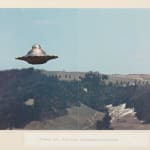Wendelle C. Stevens
Four Mock-Ups for UFO-Related Books Illustrated with Original Photos, c. 1979
Photo albums (4); chromogenic prints (approx. 115)
Photos from 3 1/2 x 5 inches to 8 x10 inches; albums each 12 1/2 x 16 1/2 inches overall
Sold
Further images
-
(View a larger image of thumbnail 1
)

-
(View a larger image of thumbnail 2
)

-
(View a larger image of thumbnail 3
)

-
(View a larger image of thumbnail 4
)

-
(View a larger image of thumbnail 5
)

-
(View a larger image of thumbnail 6
)

-
(View a larger image of thumbnail 7
)

-
(View a larger image of thumbnail 8
)

-
(View a larger image of thumbnail 9
)

-
(View a larger image of thumbnail 10
)

A quartet of maquette / presentation albums by the American UFO-logist Wendelle Stevens, with numerous photographs by Eduoard “Billy” Meier. A Swiss farmer who, in the late 1970s, created a...
A quartet of maquette / presentation albums by the American UFO-logist Wendelle Stevens, with numerous photographs by Eduoard “Billy” Meier. A Swiss farmer who, in the late 1970s, created a series of deadpan, Baldassari-like images of “beamships” hovering over these fields and farmland outside of Zurich.
Two of the works, "UFO Portraits volumes I and II," appear to be unpublished, though these books were possibly retooled and released as his book “UFO Photographs,” published in 1985. And the other two books are layouts for the second and third volumes of “UFO…Contact from the Pleiades” volumes 2 and 3. The four-part “Pleiades” series was published by Stevens in 1979.
"UFO Portraits," subtitled “Actual Photos of Real UFOS” offers the “first opportunity to view a structured UFO in detail, in flight, near the camera, in daylight at a slow enough speed for clear pictures.” It takes great pains to stress that the images are definitely, 100% genuine, and that Stevens and his team “have studied these pictures extensively with the latest technologies in existence and find them quite real.” The books go into great detail about the types of cameras that were used used to capture the spacecrafts, and often point to the technical improvements in photography as proof that there is no way the images could possibly be faked.
One humorous section shows how Stevens and his team utilized early computer technology to prove the authenticity of the images. Noting that, “Computer pattern recognition techniques were used to check and verify that there were no disturbances in the homogeneity of the grain patterns in the emulsion due to photo lab trickery such as double exposures, montages, overlay, reflected images, etc.” Of course, the lab tests proved that there were no such disturbances.
The two volumes of “Contact from the Pleiades” takes a similar approach to analyzing UFO imagery, mainly Meier’s work, and conclude that it is all without a doubt authentic. Questionably dubbed a “photo-journal,” the books are over-earnestly dedicated “to science and to those fearless few real scientists who have boldly accepted the challenge to apply their special talents to a meaningful study of the date available in this case.” The Pleiades books also contain some insight into Meier’s contact with extraterrestrials, at one point noting that he was taking too many pictures, and that the ones he had were good enough.
Taken as a whole, the albums are a remarkable, idiosyncratic example of the use of photography as a means to convince and deceive or, if one so chooses, to believe. These books are especially timely in the present age of misinformation and manipulated imagery.
Two of the works, "UFO Portraits volumes I and II," appear to be unpublished, though these books were possibly retooled and released as his book “UFO Photographs,” published in 1985. And the other two books are layouts for the second and third volumes of “UFO…Contact from the Pleiades” volumes 2 and 3. The four-part “Pleiades” series was published by Stevens in 1979.
"UFO Portraits," subtitled “Actual Photos of Real UFOS” offers the “first opportunity to view a structured UFO in detail, in flight, near the camera, in daylight at a slow enough speed for clear pictures.” It takes great pains to stress that the images are definitely, 100% genuine, and that Stevens and his team “have studied these pictures extensively with the latest technologies in existence and find them quite real.” The books go into great detail about the types of cameras that were used used to capture the spacecrafts, and often point to the technical improvements in photography as proof that there is no way the images could possibly be faked.
One humorous section shows how Stevens and his team utilized early computer technology to prove the authenticity of the images. Noting that, “Computer pattern recognition techniques were used to check and verify that there were no disturbances in the homogeneity of the grain patterns in the emulsion due to photo lab trickery such as double exposures, montages, overlay, reflected images, etc.” Of course, the lab tests proved that there were no such disturbances.
The two volumes of “Contact from the Pleiades” takes a similar approach to analyzing UFO imagery, mainly Meier’s work, and conclude that it is all without a doubt authentic. Questionably dubbed a “photo-journal,” the books are over-earnestly dedicated “to science and to those fearless few real scientists who have boldly accepted the challenge to apply their special talents to a meaningful study of the date available in this case.” The Pleiades books also contain some insight into Meier’s contact with extraterrestrials, at one point noting that he was taking too many pictures, and that the ones he had were good enough.
Taken as a whole, the albums are a remarkable, idiosyncratic example of the use of photography as a means to convince and deceive or, if one so chooses, to believe. These books are especially timely in the present age of misinformation and manipulated imagery.









